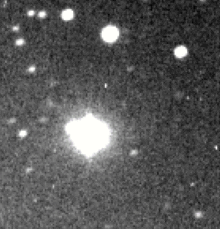216433 Milianleo
From Wikipedia, the free encyclopedia
 Animation of 216433 Milianleo from Tzec Maun Observatory | |
| Discovery | |
|---|---|
| Discovered by | Erwin Schwab[1] |
| Discovery date | February 19, 2009 |
| Designations | |
| MPC designation | 2009 DM3 |
| Alternative names | 2000 GE16 |
| Orbital characteristics | |
| Aphelion | 3.0996 AU (463.6936 Gm) |
| Perihelion | 2.3838 AU (356.6114 Gm) |
| Semi-major axis | 2.7419 AU (410.1824 Gm) |
| Eccentricity | 0.1305 |
| Orbital period | 4.54 yr |
| Mean anomaly | 339.81° |
| Inclination | 3.3502° |
| Longitude of ascending node | 12.131° |
| Argument of perihelion | 200.76° |
| Proper orbital elements | |
| Proper mean motion | 0.2171 deg / yr |
| Proper orbital period |
1658.22202 yr (605665.592 d) |
| Physical characteristics | |
| Dimensions | 2.011 km (1.250 mi).[2][lower-alpha 1] |
| Absolute magnitude (H) | 16.483[3] |
|
| |
216433 Milianleo (provisional designation: 2009 DM3) is a Main Belt asteroid. It was discovered on February 19, 2009 by E. Schwab at Tzec Maun Observatory. It is named after Milian Leo Schwab, the first-born son of the discoverer.[3][1]
Close Approaches

Orbit of Milianleo. As of September 16, 2013, it is close to its perihelion
On December 25, 2098, 216433 Milianleo is expected to pass 4,449,642 kilometers from the asteroid 704 Interamnia.[3] It will pass it at a relative velocity of 7.1177 kilometers per second.
Notes
- ↑ Assuming an albedo of 0.1
References
- ↑ 1.0 1.1 "(216433) Milianleo = 2009 DM3". Minor Planet Circular: 67220. 2009.
- ↑ "Conversion of Absolute Magnitude to Diameter for Minor Planets". Sephen F. Austin State University. Dan Burton. Retrieved 26 November 2013.
- ↑ 3.0 3.1 3.2 "216433 Milianleo (2009 DM3)". JPL Small-Body Database. Jet Propulsion Laboratory. SPK-ID: 216433.
Further reading
- Schwab, E. "Asteroid Milianleo". ErwinSchwab.de (in German).
| |||||
This article is issued from Wikipedia. The text is available under the Creative Commons Attribution/Share Alike; additional terms may apply for the media files.